belt CITROEN C-ELYSÉE 2018 Handbook (in English)
[x] Cancel search | Manufacturer: CITROEN, Model Year: 2018, Model line: C-ELYSÉE, Model: CITROEN C-ELYSÉE 2018Pages: 260, PDF Size: 8.4 MB
Page 70 of 260
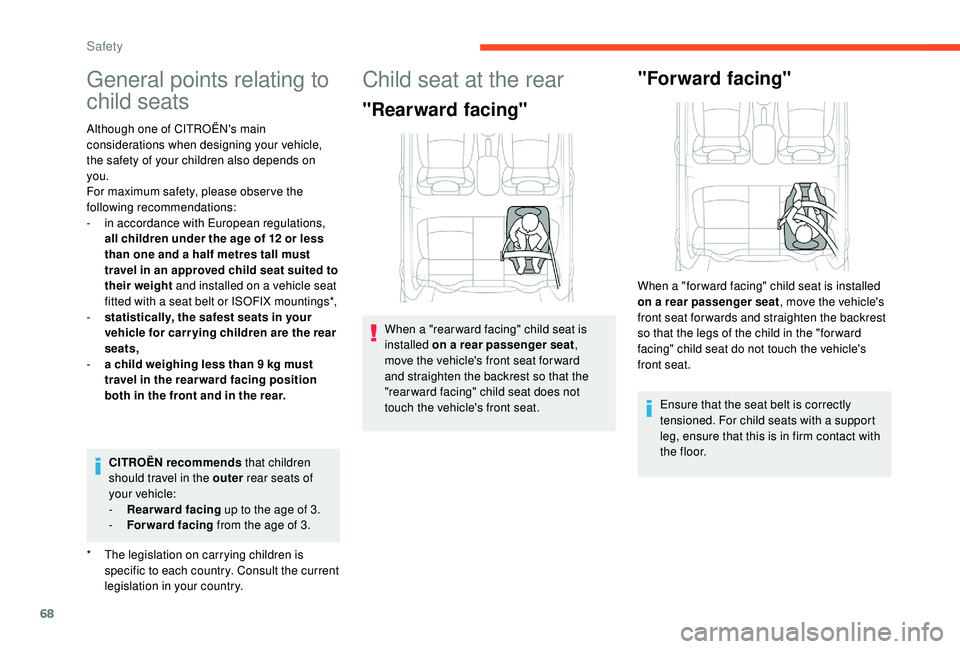
68
General points relating to
child seats
* The legislation on carrying children is specific to each country. Consult the current
legislation in your country.
Although one of CITROËN's main
considerations when designing your vehicle,
the safety of your children also depends on
you.
For maximum safety, please obser ve the
following recommendations:
-
i
n accordance with European regulations,
all children under the age of 12 or less
than one and a half metres tall must
travel in an approved child seat suited to
their weight and installed on a vehicle seat
fitted with a seat belt or ISOFIX mountings*,
-
s
tatistically, the safest seats in your
vehicle for carr ying children are the rear
seats,
-
a c
hild weighing less than 9 kg must
travel in the rear ward facing position
both in the front and in the rear.
CITROËN recommends that children
should travel in the outer rear seats of
your vehicle:
-
R
ear ward facing up to the age of 3.
-
F
or ward facing from the age of 3.
Child seat at the rear
"Rearward facing"
When a "rear ward facing" child seat is
installed on a rear passenger seat
,
move the vehicle's front seat for ward
and straighten the backrest so that the
"rear ward facing" child seat does not
touch the vehicle's front seat.
"Forward facing"
Ensure that the seat belt is correctly
tensioned. For child seats with a support
leg, ensure that this is in firm contact with
t h e f l o o r.
When a "for ward facing" child seat is installed
on a rear passenger seat
, move the vehicle's
front seat for wards and straighten the backrest
so that the legs of the child in the "for ward
facing" child seat do not touch the vehicle's
front seat.
Safety
Page 71 of 260

69
Child seat at the front
(Refer to the current legislation in your country
before installing your child on this seat.)
"Rearward facing""Forward facing"
Ensure that the seat belt is correctly
tensioned.
For child seats with a support leg, ensure
that this is in firm contact with the floor. If
necessary adjust the passenger seat.
When a "rear ward facing" child seat is installed
on the front passenger seat
, adjust the seat to
the intermediate longitudinal position, with the
backrest straightened.
The passenger's front airbag must be
deactivated. Otherwise, the child would
risk being seriously injured or killed if the
airbag were deployed . When a "for ward facing" child seat is installed
on the front passenger seat
, adjust the
vehicle's seat to the intermediate longitudinal
position with seat backrest straightened and
leave the passenger's front airbag activated. Passenger seat adjusted to the intermediate
longitudinal position.
5
Safety
Page 75 of 260
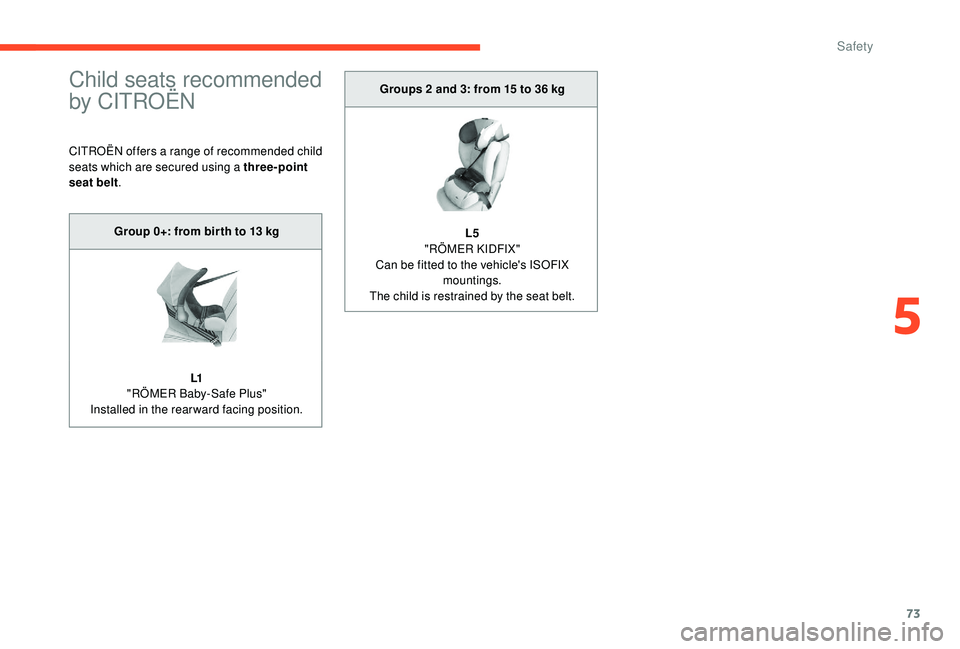
73
Child seats recommended
by CITROËN
CITROËN offers a range of recommended child
seats which are secured using a three-point
seat belt.
Group 0+: from bir th to 13
kg
L1
"RÖMER Baby-Safe Plus"
Installed in the rearward facing position. Groups 2
and 3: from 15 to 36 kg
L5
"RÖMER KIDFIX"
Can be fitted to the vehicle's ISOFIX mountings.
The child is restrained by the seat belt.
5
Safety
Page 76 of 260

74
Installing a child seat attached with the seat belt
In accordance with European regulations, this table indicates the options for installing child seats secured using a seat belt and universally approved
(a) according to the weight of the child and the seating position in the vehicle.Weight of the child/ indicative age
Seat Under 13
kg
(groups 0
(b) a n d 0 +)
Up to about 1
year9 -18
kg
(g r o u p 1)
1
to 3 years approx15 -25
kg
(group 2)
3
to 6 years approx22-36
kg
(group 3)
6
to 10 years approx
Front passenger seat
without height adjuster (c) (e) U
UUU
Rear side seats (d) UUUU
Centre rear seat XXXX
(d) When installing a child seat on a rear seat
in a rearward or forward-facing position,
move the front seat for ward then adjust
the backrest to an upright position to allow
enough room for the child seat and the
child's legs.
(e) When a "rear ward facing" child seat is
installed on the front passenger seat , it
is essential to deactivate the passenger’s
airbag. Otherwise, the child would risk
being seriously injured or killed if the
airbag were deployed . When a "for ward
facing" child seat is installed on the front
passenger seat , the passenger's airbag
must remain activated. Remove and stow the head restraint
before installing a child seat with backrest
on a passenger seat. Refit the head
restraint once the child seat has been
removed.
(a)
Universal child seat: child seat which can
be installed in all vehicles using the seat
belt.
(b) Group 0: birth to 10
kg. Infant car seats
and car cots cannot be installed in the
front passenger seat.
(c) Refer to the current legislation in your
country before putting your child in this
seat. U:
Seat suitable for the installation of a
child seat secured using a seat belt and
universally approved, rearward facing and/
or forward facing.
X: Seat not suitable for the installation of a
child seat of the weight class indicated.
Safety
Page 77 of 260
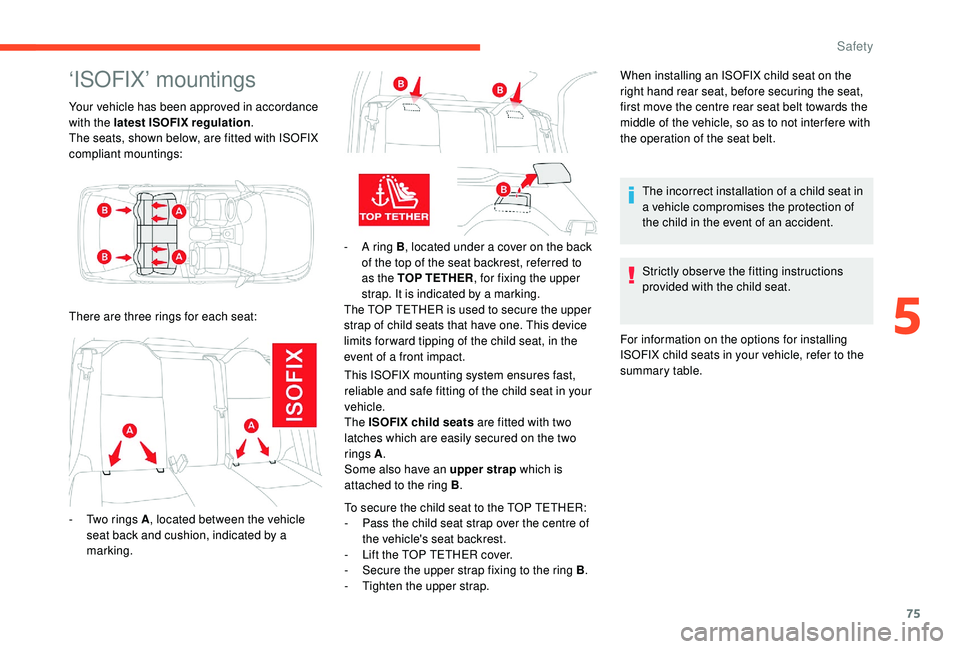
75
‘ISOFIX’ mountings
Your vehicle has been approved in accordance
with the latest ISOFIX regulation.
The seats, shown below, are fitted with ISOFIX
compliant mountings:
-
A r
ing B, located under a cover on the back
of the top of the seat backrest, referred to
as the TOP TETHER , for fixing the upper
strap. It is indicated by a marking.
The TOP TETHER is used to secure the upper
strap of child seats that have one. This device
limits for ward tipping of the child seat, in the
event of a front impact.
This ISOFIX mounting system ensures fast,
reliable and safe fitting of the child seat in your
vehicle.
The ISOFIX child seats are fitted with two
latches which are easily secured on the two
rings A .
Some also have an upper strap which is
attached to the ring B . When installing an ISOFIX child seat on the
right hand rear seat, before securing the seat,
first move the centre rear seat belt towards the
middle of the vehicle, so as to not inter fere with
the operation of the seat belt.
The incorrect installation of a child seat in
a vehicle compromises the protection of
the child in the event of an accident.
Strictly obser ve the fitting instructions
provided with the child seat.
For information on the options for installing
ISOFIX child seats in your vehicle, refer to the
summary table.
-
T
wo rings A , located between the vehicle
seat back and cushion, indicated by a
marking.
There are three rings for each seat:
To secure the child seat to the TOP TETHER:
-
P
ass the child seat strap over the centre of
the vehicle's seat backrest.
-
L
ift the TOP TETHER cover.
-
S
ecure the upper strap fixing to the ring B.
-
T
ighten the upper strap.
5
Safety
Page 78 of 260
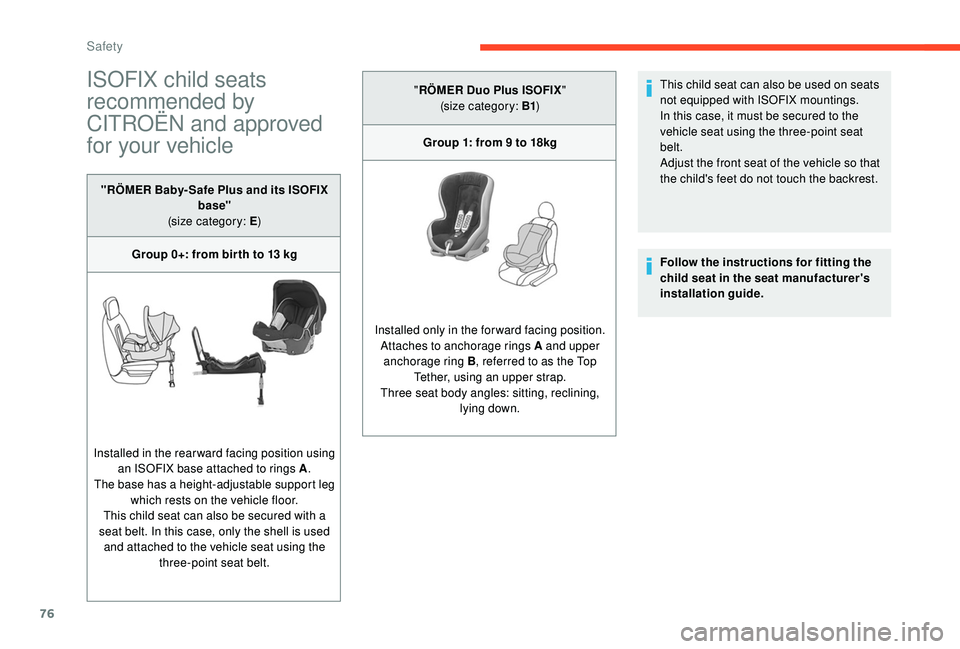
76
ISOFIX child seats
recommended by
CITROËN and approved
for your vehicle
"RÖMER Baby- Safe Plus and its ISOFIX base"
(size category: E )
Group 0+: from bir th to 13
kg
Installed in the rearward facing position using an ISOFIX base attached to rings A .
The base has a height-adjustable support leg which rests on the vehicle floor.
This child seat can also be secured with a
seat belt. In this case, only the shell is used and attached to the vehicle seat using the three-point seat belt. "
RÖMER Duo Plus ISOFIX "
(size category: B1 )
Group 1: from 9 to 18kg
Installed only in the forward facing position. Attaches to anchorage rings A and upper anchorage ring B , referred to as the Top
Tether, using an upper strap.
Three seat body angles: sitting, reclining, lying down. This child seat can also be used on seats
not equipped with ISOFIX mountings.
In this case, it must be secured to the
vehicle seat using the three-point seat
belt.
Adjust the front seat of the vehicle so that
the child's feet do not touch the backrest.
Follow the instructions for fitting the
child seat in the seat manufacturer's
installation guide.
Safety
Page 80 of 260

78
Advice
The incorrect installation of a child seat in a
vehicle compromises the child's protection in
the event of an accident.
Check that there is no seat belt or seat belt
buckle under the child seat as this could
make it unstable.
Remember to fasten the seat belts or the
child seat harnesses keeping the slack
relative to the child's body to a minimum,
even for short journeys.
When installing a child seat using the seat
belt, ensure that the seat belt is tightened
correctly on the child seat and that it secures
the child seat firmly on the seat of your
vehicle. If your passenger seat is adjustable,
move it for wards if necessary.
In the rear, always leave sufficient space
between the front seat and:
-
a "
rear ward facing" child seat,
-
t
he feet of a child seated in a "for ward
facing" child seat.
For this, move the seat for ward and, if
necessary, straighten its backrest too.
For optimal installation of the "forward facing"
child seat, ensure that its backrest is as close
as possible to the backrest of the vehicle
seat, if possible in contact with it. The head restraint must be removed before
installing a child seat with a backrest on a
passenger seat.
Ensure that the head restraint is stored or
attached securely to prevent it from being
thrown around the vehicle in the event of
sharp braking. Refit the head restraint once
the child seat has been removed.
CITROËN recommends using a booster seat
with a backrest, equipped with a belt guide at
shoulder level.
As a safety precaution, do not leave:
-
a c
hild or children alone and unattended in
a vehicle,
-
a c
hild or an animal in a vehicle exposed
to the sun, with the windows closed,
-
t
he keys within the reach of children inside
the vehicle.
To prevent accidental opening of the doors
and rear windows, use the child lock.
Take care not to open the rear windows by
more than one third.
To protect young children from the rays of the
sun, fit side blinds on the rear windows.
Children in the front
The legislation on carrying children on the
front passenger seat is specific to each
country. Refer to the legislation in force in
your country.
Deactivate the passenger's front airbag when
a "rear ward facing" child seat is installed on
the front passenger seat.
Otherwise, the child risks being seriously
injured or killed if the airbag is deployed.
Installing a booster seat
The chest part of the seat belt must be
positioned on the child's shoulder without
touching the neck.
Ensure that the lap part of the seat belt
passes correctly over the child's thighs.
Safety
Page 91 of 260
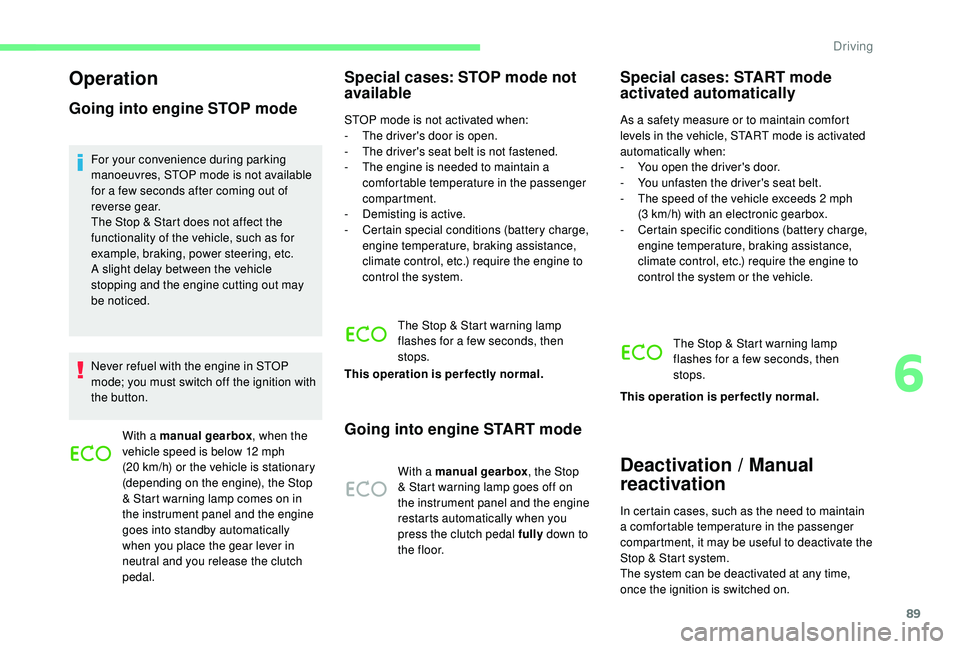
89
Operation
Going into engine STOP mode
For your convenience during parking
manoeuvres, STOP mode is not available
for a few seconds after coming out of
reverse gear.
The Stop & Start does not affect the
functionality of the vehicle, such as for
example, braking, power steering, etc.
A slight delay between the vehicle
stopping and the engine cutting out may
be noticed.
Never refuel with the engine in STOP
mode; you must switch off the ignition with
the button.With a manual gearbox , when the
vehicle speed is below 12 mph
(20 km/h) or the vehicle is stationary
(depending on the engine), the Stop
& Start warning lamp comes on in
the instrument panel and the engine
goes into standby automatically
when you place the gear lever in
neutral and you release the clutch
pedal.
Special cases: STOP mode not
available
STOP mode is not activated when:
- T he driver's door is open.
-
T
he driver's seat belt is not fastened.
-
T
he engine is needed to maintain a
comfortable temperature in the passenger
compartment.
-
D
emisting is active.
-
C
ertain special conditions (battery charge,
engine temperature, braking assistance,
climate control, etc.) require the engine to
control the system.
The Stop & Start warning lamp
flashes for a few seconds, then
stops.
This operation is perfectly normal.
Going into engine START mode
With a manual gearbox , the Stop
& Start warning lamp goes off on
the instrument panel and the engine
restarts automatically when you
press the clutch pedal fully down to
t h e f l o o r.
Special cases: START mode
activated automatically
As a safety measure or to maintain comfort
levels in the vehicle, START mode is activated
automatically when:
-
Y
ou open the driver's door.
-
Y
ou unfasten the driver's seat belt.
-
T
he speed of the vehicle exceeds 2 mph
(3
km/h) with an electronic gearbox.
-
C
ertain specific conditions (battery charge,
engine temperature, braking assistance,
climate control, etc.) require the engine to
control the system or the vehicle.
The Stop & Start warning lamp
flashes for a few seconds, then
stops.
This operation is perfectly normal.
Deactivation / Manual
reactivation
In certain cases, such as the need to maintain
a comfortable temperature in the passenger
compartment, it may be useful to deactivate the
Stop & Start system.
The system can be deactivated at any time,
once the ignition is switched on.
6
Driving
Page 138 of 260
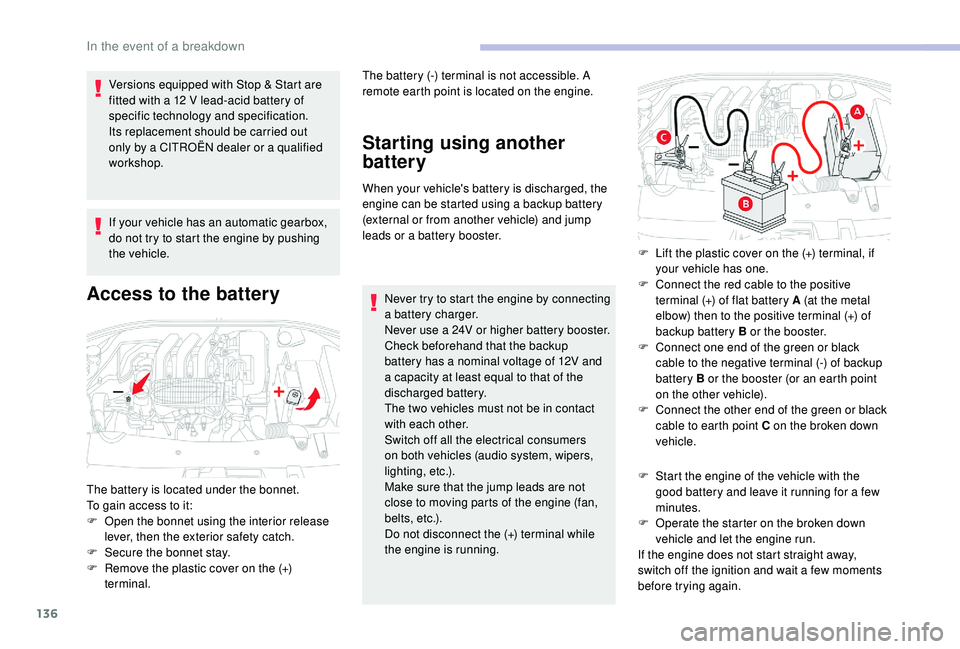
136
Versions equipped with Stop & Start are
fitted with a 12 V lead-acid battery of
specific technology and specification.
Its replacement should be carried out
only by a CITROËN dealer or a qualified
workshop.
If your vehicle has an automatic gearbox,
do not try to start the engine by pushing
the vehicle.
Access to the battery Starting using another
battery
When your vehicle's battery is discharged, the
engine can be started using a backup battery
(external or from another vehicle) and jump
leads or a battery booster.
Never try to start the engine by connecting
a battery charger.
Never use a 24V or higher battery booster.
Check beforehand that the backup
battery has a nominal voltage of 12V and
a capacity at least equal to that of the
discharged battery.
The two vehicles must not be in contact
with each other.
Switch off all the electrical consumers
on both vehicles (audio system, wipers,
lighting, etc.).
Make sure that the jump leads are not
close to moving parts of the engine (fan,
belts, etc.).
Do not disconnect the (+) terminal while
the engine is running. F
S
tart the engine of the vehicle with the
good battery and leave it running for a few
minutes.
F
O
perate the starter on the broken down
vehicle and let the engine run.
If the engine does not start straight away,
switch off the ignition and wait a few moments
before trying again.
The battery is located under the bonnet.
To gain access to it:
F
O
pen the bonnet using the interior release
lever, then the exterior safety catch.
F
S
ecure the bonnet stay.
F
R
emove the plastic cover on the (+)
terminal. The battery (-) terminal is not accessible. A
remote earth point is located on the engine.
F
L
ift the plastic cover on the (+) terminal, if
your vehicle has one.
F
C
onnect the red cable to the positive
terminal (+) of flat battery A (at the metal
elbow) then to the positive terminal (+) of
backup battery B or the booster.
F
C
onnect one end of the green or black
cable to the negative terminal (-) of backup
battery B or the booster (or an earth point
on the other vehicle).
F
C
onnect the other end of the green or black
cable to earth point C on the broken down
vehicle.
In the event of a breakdown
Page 255 of 260
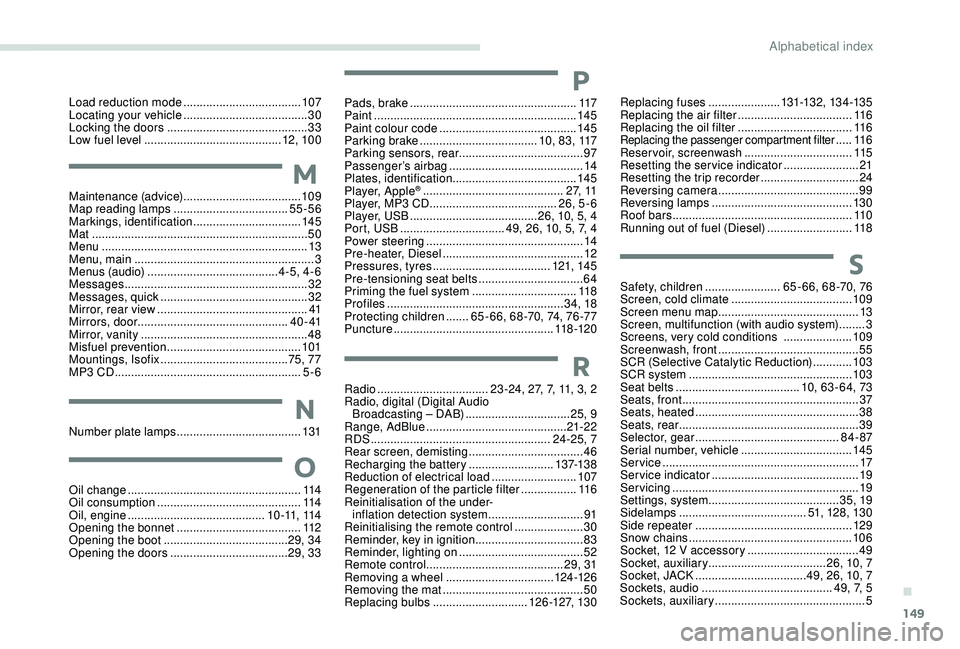
149
Maintenance (advice) ....................................10 9
Map reading lamps ................................... 55
-56
Markings, identification
.................................145
Mat
.................................................................. 50
Menu
............................................................... 13
Menu, main
....................................................... 3
M
enus (audio)
........................................ 4-5, 4-6
Messages
........................................................ 32
Messages, quick
............................................. 3
2
Mirror, rear view
.............................................. 41
Mirrors, door .............................................. 4 0 - 41
Mirror, vanity
................................................... 48
Misfuel prevention
......................................... 101
Mountings, Isofix
....................................... 75, 77
MP3
CD ......................................................... 5-6Pads, brake
...................................................
117
Paint
..............................................................
145
Paint colour code ..........................................
145
Parking brake
....................................
10, 83, 117
Parking sensors, rear ...................................... 97
Passenger’s airbag
......................................... 14
P
lates, identification
...................................... 145
Player, Apple® ........................................... 2 7, 11
Player, MP3
CD ............................... ........26, 5 - 6
Player, USB
....................................... 26, 10, 5, 4
Port, USB
................................ 49, 26, 10, 5, 7, 4
Power steering
...............................
.................14
Pre-heater, Diesel
........................................... 12
Pressures, tyres
.................................... 121, 14 5
Pre-tensioning seat belts
................................ 64
Priming the fuel system
................................ 11 8
Profiles
...................................................... 3 4, 18
Protecting children
.......65 - 66, 68 -70, 74, 76 -77
Puncture
................................................. 11 8 -12 0
Radio
.................................. 23 -24, 27, 7, 11, 3, 2
Radio, digital (Digital Audio Broadcasting – DAB)
................................ 25, 9
Range, AdBlue
........................................... 21-22
RDS
................
....................................... 24-25, 7
Rear screen, demisting
................................... 46
Recharging the battery
.......................... 137-13 8
Reduction of electrical load
.......................... 107
Regeneration of the particle filter
.................11 6
Reinitialisation of the under- inflation detection system
............................. 91
Reinitialising the remote control
..................... 3
0
Reminder, key in ignition
................................. 83
R
eminder, lighting on
...................................... 52
R
emote control
.......................................... 29, 31
Removing a wheel
................................. 124 -126
Removing the mat
........................................... 50
Replacing bulbs
............................. 12
6 -127, 13 0Safety, children
.......................65 - 66, 68 -70, 76
Screen, cold climate
.....................................10
9
Screen menu map
...........................................13
Screen, multifunction (with audio system)
........3
Screens, very cold conditions
.....................10
9
Screenwash, front
...........................................55
SCR (Selective Catalytic Reduction)
............103
SCR system
..................................................103
Seat belts
......................................10, 63 - 64, 73
Seats, front
...............................
.......................37
Seats, heated
..................................................38
Seats, rear
.......................................................39
Selector, gear
............................................84- 87
Serial number, vehicle
..................................145
Service
............................................................17
Service indicator
.............................................19
Servicing
......................................................... 19
S
ettings, system
........................................35, 19
Sidelamps
....................................... 5
1, 128, 13 0
Side repeater
................................................12 9
Snow chains
..................................................10 6
Socket, 12
V accessory ..................................49
Socket, auxiliary
.................................... 2
6, 10, 7
Socket, JACK
..................................49, 26, 10, 7
Sockets, audio
........................................ 4
9, 7, 5
Sockets, auxiliary
...............................
...............5
Oil change
.....................................................
11
4
Oil consumption
............................................ 114
Oil, engine
.......................................... 1 0 -11, 114
Opening the bonnet
...................................... 112
Opening the boot
...................................... 29, 34
Opening the doors
.................................... 29, 33
Number plate lamps
...................................... 131M
P
R
S
O
N
Load reduction mode .................................... 107
Locating your vehicle ...................................... 30
Locking the doors
........................................... 33
L
ow fuel level
.......................................... 12
, 10 0 Replacing fuses
......................131-132, 13 4 -13 5
Replacing the air filter ................................... 11
6
Replacing the oil filter
................................... 11
6
Replacing the passenger compartment filter .....116
Reservoir, screenwash
................................. 115
Resetting the service indicator
....................... 21
Resetting the trip recorder
.............................. 24
Reversing camera
...............................
............ 99
Reversing lamps
..............................
............. 13 0
Roof bars
....................................................... 11 0
Running out of fuel (Diesel)
.......................... 11 8
.
Alphabetical index